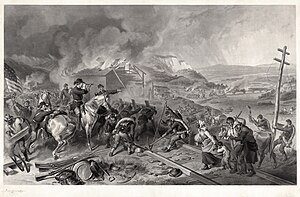
Back Shermanes Fare to Brime ANG Shermans march mod havet Danish Shermans Marsch zum Meer German Marcha de Sherman hacia el mar Spanish Shermanen itsasoranzko martxa Basque لشکرکشی شرمن به سمت دریا Persian Marche de Sherman vers la mer French הצעדה אל הים HE Marcia di Sherman verso il mare Italian 海への進軍 Japanese
| Sherman's March to the Sea | |||||||
|---|---|---|---|---|---|---|---|
| Part of the American Civil War | |||||||
 Sherman's March to the Sea, Alexander Hay Ritchie | |||||||
| |||||||
| Belligerents | |||||||
|
|
| ||||||
| Commanders and leaders | |||||||
|
|
| ||||||
| Units involved | |||||||
|
Army of the Tennessee[1] Army of Georgia[1] | Department of South Carolina, Georgia, and Florida | ||||||
| Strength | |||||||
| 62,204[2] | 12,466[3] | ||||||
| Casualties and losses | |||||||
| More than 1,300 casualties | Around 2,300 casualties | ||||||
| Economic loss: $100 million[4] | |||||||
Sherman's March to the Sea (also known as the Savannah campaign or simply Sherman's March) was a military campaign of the American Civil War conducted through Georgia from November 15 until December 21, 1864, by William Tecumseh Sherman, major general of the Union Army. The campaign began on November 15 with Sherman's troops leaving Atlanta, recently taken by Union forces, and ended with the capture of the port of Savannah on December 21. His forces followed a "scorched earth" policy, destroying military targets as well as industry, infrastructure, and civilian property, disrupting the Confederacy's economy and transportation networks.
The operation debilitated the Confederacy and helped lead to its eventual surrender.[5] Sherman's decision to operate deep within enemy territory without supply lines was unusual for its time, and the campaign is regarded by some historians as an early example of total war or "hard war" in modern warfare.
Following the March to the Sea, Sherman's army headed north for the Carolinas campaign. The portion of this march through South Carolina was even more destructive than the Savannah campaign, since Sherman and his men harbored much ill-will for that state's part in bringing on the Civil War; the following portion, through North Carolina, was less so.[6]
- ^ a b Further information: "Savannah Campaign Union order of battle" (Official Records, Series I, Volume XLIV, pp. 19–25)
- ^ Further information: "Effective strength of the army in the field under Maj. Gen. William T. Sherman, November and December, 1864" (Official Records, Series I, Volume XLIV, p. 16)
- ^ Further information: "Abstract from return of the Department of South Carolina, Georgia and Florida, Lieut. Gen. W.J. Hardee commanding, November 20, 1864" (Official Records, Series I, Volume XLIV, p. 874)
- ^ Catton, pp. 415–16.
- ^ Hudson, Myles (2023). "Sherman's March to the Sea". Encyclopedia Britannica. Retrieved 30 January 2023.
- ^ Glatthar, pp. 78–80